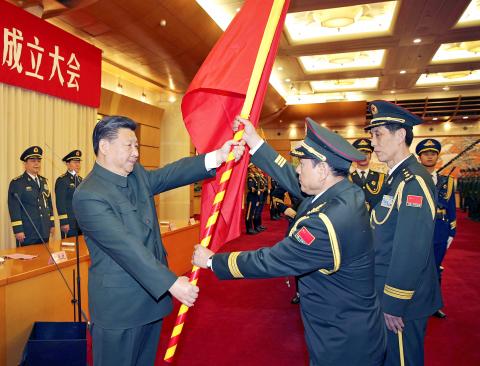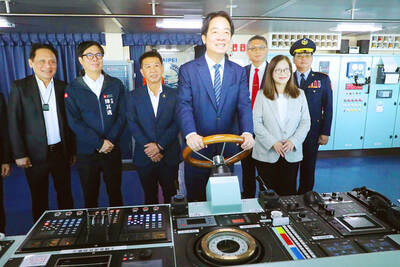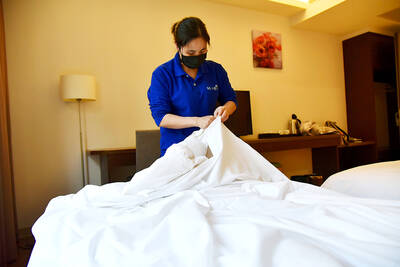China has unveiled changes to the structure of its military, adding three new units, described by Chinese President Xi Jinping (習近平) as “a major policy decision to realize the Chinese dream of a strong army,” state media reported.
The formation of the new units, which follows Beijing’s announcement that it was building a second aircraft carrier, comes with China acting more aggressively in territorial disputes in the South China Sea and East China Sea, drawing the ire of its neighbors and the US.
Beijing in November last year said it planned sweeping changes in a move intended to enhance the ruling Chinese Communist Party’s control over the People’s Liberation Army (PLA).

Photo: AP
The latest reforms announced late on Friday are to see a new army unit set up to oversee China’s arsenal of strategic missiles.
Besides the “Rocket Force,” the PLA also unveiled an army general command to serve as the headquarters for land forces and a support unit to assist combat troops, the official Xinhua news agency said.
Xi, who is chief of the Chinese Communist Party and also serves as head of the military, has previously announced plans to slash China’s number of troops by 300,000 to about 2 million to craft a more efficient fighting force.
The Central Military Commission, which Xi chairs, on Friday also released guidelines to help build the country’s vision of a modern military before 2020 by cutting troops and improving the quality of combat personnel, Xinhua said.
The announcements come with China also expanding its naval capacity by building a second aircraft carrier.
The nation’s first such vessel, the Liaoning, is a secondhand Soviet ship built more than 25 years ago that was commissioned by China in 2012 after extensive refits.
The Global Times newspaper, known for its nationalistic editorial stance, said new conditions required a strong army and cited the US as a reason.
“If China has a big gap with the US in terms of military prowess, this will affect its international position and other countries’ attitude toward China,” it said in an editorial posted on its Web site yesterday. “With a strong army, China can be more politically appealing, influential and persuasive.”
Beijing’s armed forces have been involved in sometimes tense confrontations with Japanese and Philippine units over maritime disputes in the East China Sea and South China Sea respectively, prompting fears that the disputes could result in armed clashes.
Meanwhile, the new PLA Rocket Force is tasked with maintaining conventional and nuclear weaponry with the ability to both deter and to strike, Xi told a ceremony for the founding of the three new organizations, according to Xinhua.
However, a spokesman for the Chinese Ministry of National Defense denied any shift in the country’s nuclear weapons policy.
“China’s nuclear policy and nuclear strategy are consistent, there has been no change whatsoever,” ministry spokesman Yang Yujun (楊宇軍) said on Friday, according to a transcript posted on the ministry’s Web site.
The new unit would take over from the Second Artillery Force, he said.
At a military parade in September last year, China showed off “carrier-killer” missiles, including the land-based DF-21 Mod-4 intermediate-range type, which is thought to be equipped with onboard terminal guidance systems that give it the unprecedented ability to attack a moving target.
A Chinese analyst said the latest moves were aimed at modernizing the military.
“For a long time, China had no overseas interests. The navy, air force and guided-missile units were relatively weak compared with the army,” Shanghai University of Political Science and Law professor Ni Lexiong (倪樂雄) told reporters.
“To catch up with European and American powers ... China must raise the modernization level and combat strength of the army,” he added.

CALL FOR SUPPORT: President William Lai called on lawmakers across party lines to ensure the livelihood of Taiwanese and that national security is protected President William Lai (賴清德) yesterday called for bipartisan support for Taiwan’s investment in self-defense capabilities at the christening and launch of two coast guard vessels at CSBC Corp, Taiwan’s (台灣國際造船) shipyard in Kaohsiung. The Taipei (台北) is the fourth and final ship of the Chiayi-class offshore patrol vessels, and the Siraya (西拉雅) is the Coast Guard Administration’s (CGA) first-ever ocean patrol vessel, the government said. The Taipei is the fourth and final ship of the Chiayi-class offshore patrol vessels with a displacement of about 4,000 tonnes, Lai said. This ship class was ordered as a result of former president Tsai Ing-wen’s (蔡英文) 2018

UKRAINE, NVIDIA: The US leader said the subject of Russia’s war had come up ‘very strongly,’ while Jenson Huang was hoping that the conversation was good Chinese President Xi Jinping (習近平) and US President Donald Trump had differing takes following their meeting in Busan, South Korea, yesterday. Xi said that the two sides should complete follow-up work as soon as possible to deliver tangible results that would provide “peace of mind” to China, the US and the rest of the world, while Trump hailed the “great success” of the talks. The two discussed trade, including a deal to reduce tariffs slapped on China for its role in the fentanyl trade, as well as cooperation in ending the war in Ukraine, among other issues, but they did not mention

HOTEL HIRING: An official said that hoteliers could begin hiring migrant workers next year, but must adhere to a rule requiring a NT$2,000 salary hike for Taiwanese The government is to allow the hospitality industry to recruit mid-level migrant workers for housekeeping and three other lines of work after the Executive Yuan yesterday approved a proposal by the Ministry of Labor. A shortage of workers at hotels and accommodation facilities was discussed at a meeting of the legislature’s Transportation Committee. A 2023 survey conducted by the Tourism Administration found that Taiwan’s lodging industry was short of about 6,600 housekeeping and cleaning workers, the agency said in a report to the committee. The shortage of workers in the industry is being studied, the report said. Hotel and Lodging Division Deputy Director Cheng

‘SECRETS’: While saying China would not attack during his presidency, Donald Trump declined to say how Washington would respond if Beijing were to take military action US President Donald Trump said that China would not take military action against Taiwan while he is president, as the Chinese leaders “know the consequences.” Trump made the statement during an interview on CBS’ 60 Minutes program that aired on Sunday, a few days after his meeting with Chinese President Xi Jinping (習近平) in South Korea. “He [Xi] has openly said, and his people have openly said at meetings, ‘we would never do anything while President Trump is president,’ because they know the consequences,” Trump said in the interview. However, he repeatedly declined to say exactly how Washington would respond in